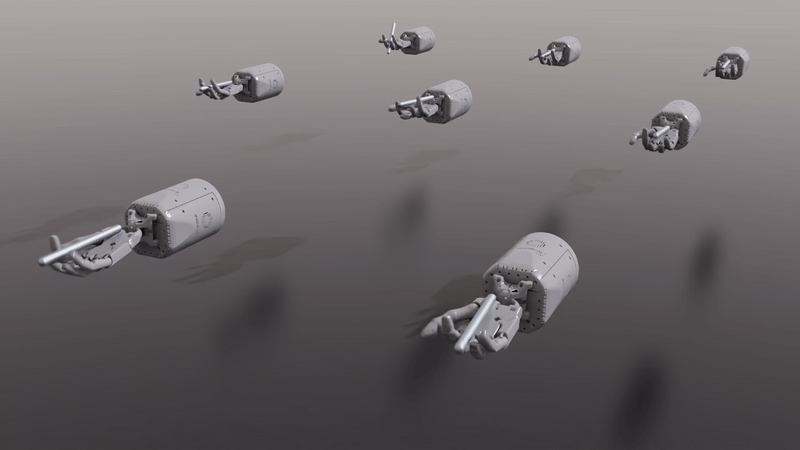Chase after each other! NVIDIA and Meta announced significant achievements in robotics on the same day
Advertising space rental
Advertising space rental
Science and Technology Innovation Board Daily, October 21st (Editor Song Ziqiao)Nowadays, technology giants are actively shouldering the responsibility of robot research and development, and are racing to the next technology feast. On October 20th local time, NVIDIA and Meta each released heavyweight robot training tools
Science and Technology Innovation Board Daily, October 21st (Editor Song Ziqiao)Nowadays, technology giants are actively shouldering the responsibility of robot research and development, and are racing to the next technology feast. On October 20th local time, NVIDIA and Meta each released heavyweight robot training tools.
The AI agent Eureka developed by NVIDIA can teach robots complex motion control skills, such as turning pens, opening drawers and cabinets, throwing and receiving balls, and operating scissors. Nvidia claims that this breakthrough will redefine machine learning.
Meta has launched the Habitat3.0 simulator, which can teach robots how to interact with the physical world. Meta calls it a "milestone in the development of social intelligent robots".
What kind of tool is it? What is the significance of new achievements?
NVIDIA Eureka - Large model participation in training robots
Eureka's full name is Evolution driven Universal Reward KitforAgent, which is essentially an algorithm generation tool driven by large models. With the help of GPT-4's ability to write code, Eureka has excellent ability to design reward functions and can independently write reward algorithms to train robots.
The key to Eureka is the implementation of human level reward algorithm design through context. Simply put, it means using GPT-4's zero sample generation, code writing, and context improvement functions to optimize reward execution strategies, thereby enabling complex skills to be developed through reinforcement learning.
Nvidia states that the performance of Eureka reward designs has reached human level in 29 different open source reinforcement learning (RL) environments, including 10 different robot forms (quadruped robots, quadrotor robots, bipedal robots, robotic arms, and several dexterous hands). In the absence of any specific task prompts or reward templates, Eureka generated reward programs outperform those written by experts in over 80% of tasks. This improves the average performance of the robot by over 50%.



Robots have learned to turn pens, open cabinets, and throw balls through Eureka (note: the scene of these robotic fingers flipping up and down is temporarily limited to virtual environments)


Humanoid robots learn running gait through Eureka
Nvidia's research was conducted in collaboration with researchers from the University of Pennsylvania, California Institute of Technology, and the University of Texas at Austin. At present, the project is fully open source.
In the field of robotics, there is a "Moravik paradox" - the unique high-order intelligence ability of humans only requires very little computational power, but unconscious skills and intuition (such as recognizing faces, lifting pencils, walking around rooms, answering questions, etc.) require great computational power, that is, the simpler things are, the harder things are.
This is also why humans have already created AlphaGo, which defeats the world's top chess players, but still cannot give robots the same perception and mobility as two or three year old children.
Nvidia's latest achievements demonstrate the role of large models in fine control of robotsDriven by Nvidia, more intelligent machine learning methods are expected to be rapidly introduced into industrial and consumer applications.
MetaHabitat - Human machine interaction directly refers to embodied intelligence
Meta's Habitat is also designed for training robots. It is reported that Habitat3.0 is the first simulator to support large-scale training on human-computer interaction tasks in diverse and realistic indoor environments.

Specifically, Habitat3.0 can use infrared capture systems to meticulously construct a virtual environment, such as office spaces, residences, and warehouses, where the shape and size of objects completely replicate the real world. The tool can also simulate humans in terms of appearance and posture, supporting various types of actions from simple (such as walking and waving) to complex (such as interacting with objects), and can also simulate various real social scenes.


The human avatar in a virtual environment can be controlled by learned strategies, as well as by a real person through keyboard, mouse, and VR head display. Some people are already looking forward to experiencing Habitat3.0 in MetaQuestVR online.

The purpose of Meta is very clear - through Habitat3.0, AI agents can interact with humans in the real world.
MetaAIFAIRHabitat 3.0.
FAIR indicates that,Habitat3.0 will shorten the learning time of robot AI agents from a few months or even years to a few days..
Habitat 3.0MetaHabitatHabitat Synthetic Scenes DatasetHome Robot.

Meta.
Huawei's "genius boy", Zhi Huijun, left Huawei and went to start a robot business. He once quoted an online joke on his robot product debut: "What we want AI to do is cook, clean the room, wash clothes, and throw garbage, but what they are actually doing is chatting, painting, writing, composing, playing games
.
How far is a household robot that takes care of household chores and chores from us?
Tag: Chase after each other NVIDIA and Meta announced significant
Advertising space rental
Advertising space rental
Disclaimer: The content of this article is sourced from the internet. The copyright of the text, images, and other materials belongs to the original author. The platform reprints the materials for the purpose of conveying more information. The content of the article is for reference and learning only, and should not be used for commercial purposes. If it infringes on your legitimate rights and interests, please contact us promptly and we will handle it as soon as possible! We respect copyright and are committed to protecting it. Thank you for sharing.



